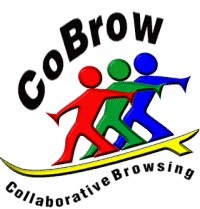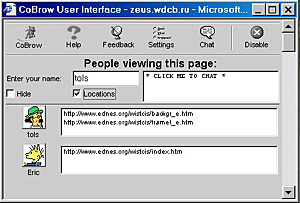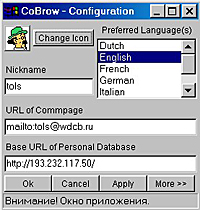Collaborative Browsing Toolkit (CoBrow)


"Collaborative Browsing in Information Resources - Tools and Services"
"Virtual awareness" is a new form of Web-based communication centred around the notion of "virtual vicinity". The idea is to add typical human interaction patterns to Web-surfing. Virtual Presence Services allow Web-users to see each other while they are present on a Web-page or on linked page. This tool is a crucial one to extend co-operation between telematics communities in EU and the CIS countries, since it can establish immediate teleworking mode between parties that visit the same or related pages.
The toolkit developed by TAP projects CoBrow (RE 1003) and CoBrow/D (RE 4003) under the leadership of University of Ulm, Germany, will be adapted for use in the CIS countries for EU-CIS team work in research, education and training, environmental and business activities. Primary focus is the extended multilinguality, specifically support of the Russian language including non-Latin character sets. A considerable part of the work will be changes to the user interface of Cobrow to enable usage of Russian language. Examples are the support of the ISO 8859-5 character set and a Russian language user interface together with help files and a user manual.
CoBrow goals
 bring together users of the WWW
bring together users of the WWW
 provide Virtual Presence on the Web (i.e., Web-users are able to see each other on Web-pages)
provide Virtual Presence on the Web (i.e., Web-users are able to see each other on Web-pages)
 let people communicate on such locations
let people communicate on such locations
CoBrow mechanism
1. Generates meetings in a dynamic mode based on the concept of vicinities
2. Establishes temporary groups of users based on their transient vicinity, which may be interested in communicating with each other
3. Gives means of communication, anything from a simple chat tool to a full fledged tele-conferencing and application sharing system
CoBrow advantages
 Finds other persons browsing the same page or pages in your vicinity
Finds other persons browsing the same page or pages in your vicinity
 Transforms the Web into a virtual space where people meet on Web-pages
Transforms the Web into a virtual space where people meet on Web-pages
 No more dedicated forums and chat rooms. You can meet on every page
No more dedicated forums and chat rooms. You can meet on every page
 Makes the other users visible; it shows the icons and names of those in the vicinity
Makes the other users visible; it shows the icons and names of those in the vicinity
 A text based chat is already integrated
A text based chat is already integrated
 Internet telephony can be started by a simple click on the other person's icon
Internet telephony can be started by a simple click on the other person's icon
 Extends Web-servers (software is added to existing Web-sites)
Extends Web-servers (software is added to existing Web-sites)
 The document database remains untouched
The document database remains untouched
 Does not require client software installation
Does not require client software installation
Examples of use
| Application |
Advantages for users |
Advantages for Web-sites |
| Virtual Shopping |
See other customers and sales staff |
Sales staff notices customers entering a virtual store. They can talk to customers while they are in the store |
| Web-based CSCW |
See other online participants |
Augment asynchronous collaboration with synchronous collaboration |
| Replacement for Chat Rooms |
Users are able to talk to each other on every page (unless pages are excluded by site operator) |
No chat software to be installed on the client. Increased flexibility. Pages can be clustered to chat areas |
| User Tracking |
|
Site operators can watch users browsing the pages live. Icons of users move from page to page in a 3-dimensional site display |
| Chance Meetings on the Web |
People 'bump into' each other on a CoBrow enabled Web-site like they do in the real world, at real street corners, in shops, etc. |
Authors can be permanently present on their pages. Users see them and can talk to them |
CoBrow user interface basic capability
 Display other neighbor's locations
Display other neighbor's locations
 Chat between neighbors
Chat between neighbors
 Hiding
Hiding
 Enabling/disabling CoBrow
Enabling/disabling CoBrow
 Definition of an icon and user name
Definition of an icon and user name
 Setting communication URL
Setting communication URL
 Setting base URL of user details
Setting base URL of user details
 Setting preferred languages
Setting preferred languages


System requirements
- small or medium Web-site
- Netscape 3.01 and MSIE 3.0 or higher, any Java compatible Web-browser
Hardware requirements
- PC: Pentium class 133Mhz / 32Mb
- Sun: SS10 / 64 Mb
Server system software platforms
- Windows NT 4.0
- Windows 95/98
- SunOS / Solaris 2.x
- Linux 2.x
Windows Web-server compatibility
- Microsoft Internet Information Server
- Microsoft NT Workstation Peer Web Services (Option Pack 3)
- Windows 95 with PWS 4.0 (Personal Web-Server)
Linux / SunOS / Solaris 2.x server compatibility
Apache, Sun Web-Server, W3C/Cern, etc.





 bring together users of the WWW
bring together users of the WWW
